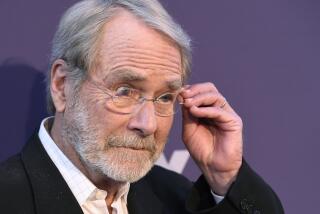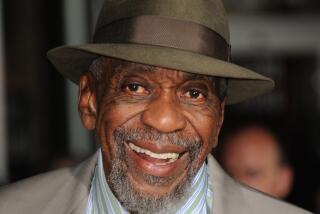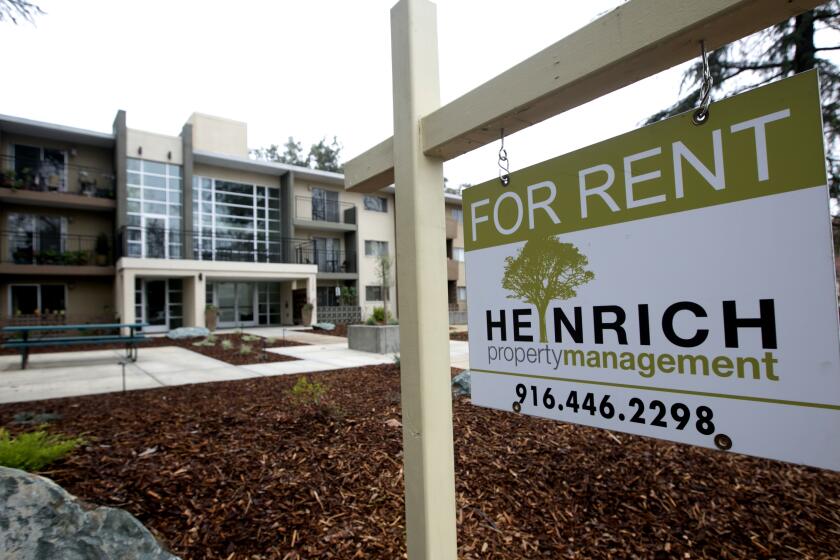Andy Griffith, folksy TV sheriff and comedian, dies at 86
Andy Griffith was starring on Broadway in the 1959 musical comedy “Destry Rides Again” when he told his agent that he was ready for a new challenge: He wanted his own television series.
His chance came in 1960, when Sheldon Leonard, the producer of “The Danny Thomas Show,” developed an idea that would exploit the actor’s homespun image: Griffith would play Andy Taylor, the sheriff in a series set in a mythical North Carolina town called Mayberry.
“The Andy Griffith Show” made its debut that fall with Ronny Howard as the widowed sheriff’s young son, Opie, and Frances Bavier as matronly Aunt Bee. The series quickly became one of the decade’s most popular shows and made Griffith one of television’s most beloved stars.
Griffith, 86, died Tuesday at his home on North Carolina’s Roanoke Island, according to a family statement read by Dare County Sheriff Doug Doughtie. No cause was given, but Griffith had a heart attack and underwent quadruple bypass surgery in 2000.
A former North Carolina high school music teacher, Griffith launched his career as an entertainer in the early 1950s by writing and performing comic monologues for civic clubs that he delivered in an exaggerated Southern drawl that he once described as “sounding like three yards out on a Carolina swamp.”
Before the end of the decade, he was a star known for his Tony-nominated Broadway performance as a hayseed recruit in “No Time for Sergeants” and his film debut as an Arkansas vagabond who becomes a power-hungry TV sensation in director Elia Kazan’s dark drama “A Face in the Crowd.”
His portrayal of Sheriff Andy Taylor on “The Andy Griffith Show,” which aired on CBS from 1960 to 1968, gave him a place in television history as one of the medium’s most memorable characters, alongside such iconic TV fathers as Robert Young of “Father Knows Best” and Lorne Greene of “Bonanza.”
Griffith scored a second triumph on series television starring in “Matlock,” the legal drama that ran from 1986 to 1995 on NBC and ABC. He played Benjamin L. Matlock, a Harvard-educated lawyer with a down-home sensibility.
As an actor, he learned early on to play to his strengths.
“Any time I try to play anything that doesn’t come natural, I’m just plain bad,” he once told TV Guide.
As Sheriff Taylor, his most famous role, he was just plain good.
He made his debut as the avuncular sheriff in early 1960 during a guest spot on CBS’ “The Danny Thomas Show,” in which Sheriff Taylor picked up nightclub entertainer Danny for speeding through Mayberry on his way to Miami.
“The Andy Griffith Show” earned a spot on the network’s fall lineup and high ratings for eight seasons.
Comic actor Don Knotts, who had a supporting role alongside Griffith in the Broadway and film versions of “No Time for Sergeants,” had seen the “Danny Thomas Show” episode and called to suggest that Andy Taylor should have a deputy.
The addition of Knotts as the incompetent but full-of-bravado Barney Fife quickly shifted the balance of the show.
“I was supposed to have been the comic, the funny one,” Griffith told The Times in 1993. The series, he said, “might not have lasted even half a season that way, but when Don came on I realized by the second episode Don should be funny and I should play straight to him.”
The unflappable Andy and the all-too-excitable Barney became one of television’s greatest comedy duos.
The show’s laughs came not from the characters telling jokes back and forth but typically, as in real life, out of ordinary conversations.
One of Griffith’s favorite exchanges with Knotts came in an episode in which Barney had saved $300 to buy a car.
Barney: The last big buy I made was my mom’s and dad’s anniversary present.
Andy: What’d ya get `em?
Barney: A septic tank.
Andy: For their anniversary?
Barney: They’re awful hard to buy for. Besides, it was something they can use. They were really thrilled. It had two tons of concrete in it. All steel reinforced.
Andy: You’re a fine son, Barn.
Barney: I try.
As a TV Guide reporter put it in a 1963 article on the show’s popularity: “Such dialogue — read with sly amusement by Griffith, unflinching earnestness by Knotts — demands an extraordinarily high degree of comedy acting and a solid grasp of the subtleties of character.”
Considered the driving force behind the series, Griffith was heavily involved with the show’s production and helped shape the scripts and characterizations.
George Lindsey, who joined the series in 1965 as Goober, told The Times in 1993: “He is probably the best script constructionist that ever was.” Griffith, he added, “made you operate at 110% because you brought yourself up to his level.”
Lindsey died in May and Knotts in 2006.
Ron Howard, who grew up to become one of Hollywood’s top directors, considered Griffith “like a wonderful uncle to me.”
Griffith “created an atmosphere of hard work and fun that I try to bring to my movies,” Howard told People magazine in 1986.
When Griffith and most of the major cast members reunited for “Return to Mayberry” in 1986, it was one of the highest-rated TV movies of the year.
“The backbone of our show was love,” Griffith once said. “There’s something about Mayberry and Mayberry folk that never leaves you.”
The small-town atmosphere depicted in Mayberry wasn’t far from Griffith’s own boyhood in Mount Airy, N.C., a small town in the foothills of the Blue Ridge Mountains, where he was born June 1, 1926.
An only child, Griffith grew up singing and playing guitar with his mother. He learned to tell funny stories from his father, who earned a modest living at the Mount Airy Furniture Co.
Griffith majored in music at the University of North Carolina at Chapel Hill and dreamed of becoming a professional singer on stage. On a whim, he auditioned for a campus production of Gilbert and Sullivan’s “The Gondoliers.”
“I loved it,” Griffith recalled in a 1996 National Public Radio interview. “I had two songs, two solos. I got good reviews. It said I had good timing and so I played the comedy leads in all the Gilbert and Sullivans they did while I was there.”
After graduating in 1949, Griffith taught music at a high school in Goldsboro, N.C. But he and his first wife, Barbara, a singer and musician who had been a member of the university drama group, continued acting in North Carolina’s famous annual outdoor drama, “The Lost Colony,” on Roanoke Island.
After receiving a negative comment about his singing at one audition, Griffith abandoned his dream of a singing career. Not wanting to teach anymore, he wrote a few jokes and did his first monologue, which he delivered in a thick Southern accent.
“I told the story of the play ‘Hamlet’ at the Shrine Club,” he later recalled in a National Public Radio interview. “I got big laughs and I never taught again.”
Plying the “Rotary Club circuit” as an entertainer with his wife, Griffith began doing humorous monologues on “Romeo and Juliet,” the opera “Carmen” and the ballet “Swan Lake.”
But he earned some of his biggest laughs with his football spoof in which a country preacher sees his first football game but has no idea what he’s watching:
“And I think that it’s some kind of a contest where they see which bunch full of them men can take that pumpkin and run from one end of that cow pasture to the other without either getting knocked down or stepping in something.”
A local record company recorded Griffith’s “What It Was, Was Football” and it began receiving so much radio air play that Capitol Records’ New York promotion man Richard O. Linke flew to North Carolina to buy the master recording and sign Griffith to a personal-management contract.
“I dealt with a lot of record personalities,” Linke told TV Guide in 1960, “but I just had a feeling that this Griffith kid had a lot more on the ball than most. Fortunately, I was right.”
Griffith’s comic flair was on full display as the country bumpkin draftee in the 1955 Broadway hit “No Time for Sergeants.” He reprised his role in the 1958 movie version of the play.
He pitched himself for the role of drifter Lonesome Rhodes in “A Face in the Crowd,” but neither Kazan nor screenwriter Budd Schulberg thought he was right for the role. Schulberg told him he was too “nice” to play such a dark character. But after the actor did an impression of evangelist Oral Roberts “healing” the director, Griffith told The Times in 2005, Kazan “hired me the next day.” Critic James Wolcott wrote years later that Griffith unleashed “a moody, gutsy force unsuitable for the future sheriff of Mayberry.”
“The Andy Griffith Show” was in the Nielsen Top 10 for its entire eight-season run. When its star voluntarily left the show in 1968 it was ranked No. 1.
He starred in only one post-TV series film — “Angel in My Pocket,” a 1969 family comedy that bombed — before attempting to reestablish himself as a TV star. On CBS in 1970, he played the title role in “The Headmaster,” a short-lived dramatic series about a private high school.
He struck out again in 1971 with “The New Andy Griffith Show” on CBS, in which he returned to his sitcom roots playing a married father of two children who becomes mayor of a small Southern town.
Over the decade, Griffith co-starred with Jeff Bridges in the movie comedy “Hearts of the West” and appeared in occasional TV movies and miniseries (“Centennial” and “Roots: The Next Generation”), as well as making a few other series comeback attempts.
But, as he later put it, “I fell out of fashion. The phone didn’t ring much.”
In 1983, two years after receiving an Emmy nomination for his supporting role in the TV movie “Murder in Texas,” Griffith was stricken with Guillain-Barre syndrome, a rare disorder in which the body’s immune system attacks part of the peripheral nervous system.
“In a matter of hours, my legs were paralyzed,” he later told People magazine.
After six months of extensive physical therapy, however, he fully recovered and returned to acting — including a role in the 1984 miniseries “Fatal Vision” before launching “Matlock” in 1986. His final role was in the 2009 film “Play the Game.”
Griffith, who was inducted into the TV Academy Hall of Fame in 1992, received a 1997 Grammy for his album “I Love to Tell The Story — 25 Timeless Hymns.”
When Griffith received the Presidential Medal of Freedom, America’s highest civil award, at a White House ceremony in 2005, PresidentGeorge W. Bush thanked him for being “such a friendly and beloved presence in our American life.”
Griffith and his first wife had two children: Sam, who died in 1996, and Dixie. Twice divorced, he married his third wife, Cindi Knight Griffith, in 1983.
Times staff writer Elaine Woo contributed to this report.
More to Read
Start your day right
Sign up for Essential California for news, features and recommendations from the L.A. Times and beyond in your inbox six days a week.
You may occasionally receive promotional content from the Los Angeles Times.






